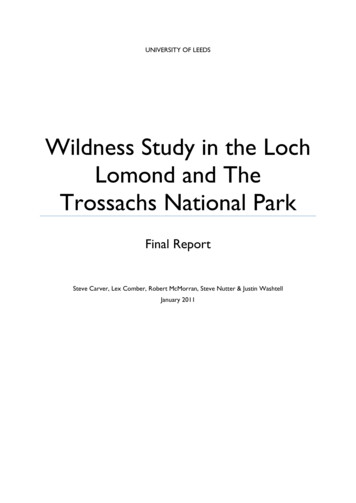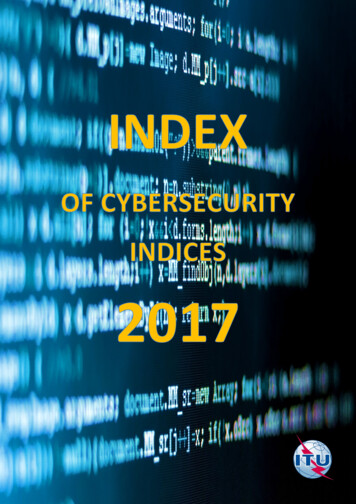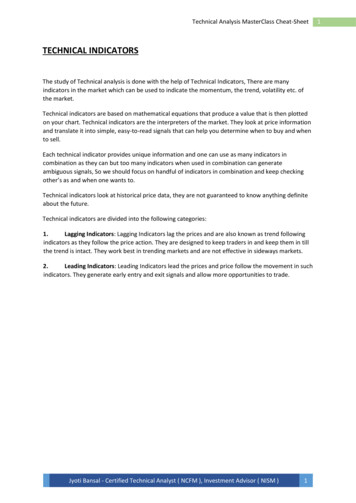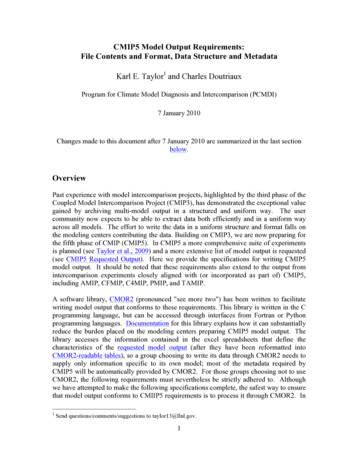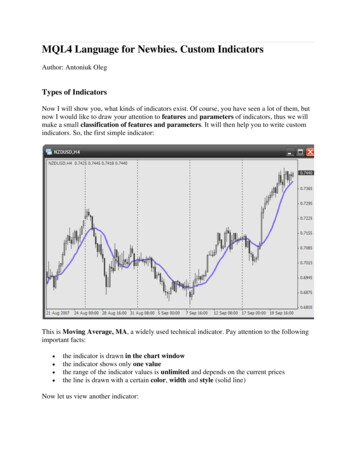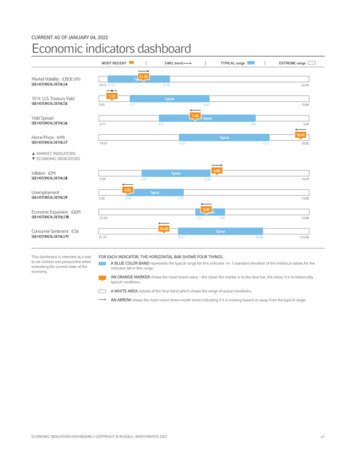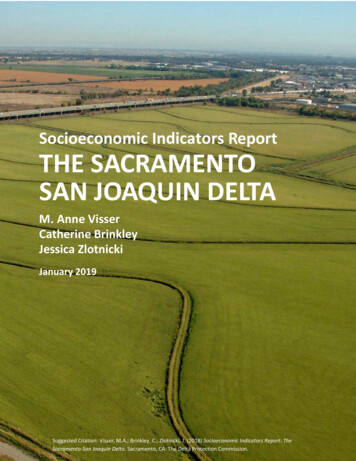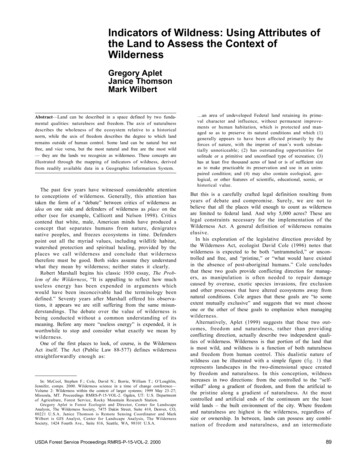
Transcription
Indicators of Wildness: Using Attributes ofthe Land to Assess the Context ofWildernessGregory ApletJanice ThomsonMark WilbertAbstract—Land can be described in a space defined by two fundamental qualities: naturalness and freedom. The axis of naturalnessdescribes the wholeness of the ecosystem relative to a historicalnorm, while the axis of freedom describes the degree to which landremains outside of human control. Some land can be natural but notfree, and vice versa, but the most natural and free are the most wild— they are the lands we recognize as wilderness. These concepts areillustrated through the mapping of indicators of wildness, derivedfrom readily available data in a Geographic Information System.The past few years have witnessed considerable attentionto conceptions of wilderness. Generally, this attention hastaken the form of a “debate” between critics of wilderness asidea on one side and defenders of wilderness as place on theother (see for example, Callicott and Nelson 1998). Criticscontend that white, male, American minds have produced aconcept that separates humans from nature, denigratesnative peoples, and freezes ecosystems in time. Defenderspoint out all the myriad values, including wildlife habitat,watershed protection and spiritual healing, provided by theplaces we call wilderness and conclude that wildernesstherefore must be good. Both sides assume they understandwhat they mean by wilderness; neither states it clearly.Robert Marshall begins his classic 1930 essay, The Problem of the Wilderness, “It is appalling to reflect how muchuseless energy has been expended in arguments whichwould have been inconceivable had the terminology beendefined.” Seventy years after Marshall offered his observations, it appears we are still suffering from the same misunderstandings. The debate over the value of wilderness isbeing conducted without a common understanding of itsmeaning. Before any more “useless energy” is expended, it isworthwhile to stop and consider what exactly we mean bywilderness.One of the first places to look, of course, is the WildernessAct itself. The Act (Public Law 88-577) defines wildernessstraightforwardly enough as:In: McCool, Stephen F.; Cole, David N.; Borrie, William T.; O’Loughlin,Jennifer, comps. 2000. Wilderness science in a time of change conference—Volume 2: Wilderness within the context of larger systems; 1999 May 23–27;Missoula, MT. Proceedings RMRS-P-15-VOL-2. Ogden, UT: U.S. Departmentof Agriculture, Forest Service, Rocky Mountain Research Station.Gregory Aplet is Forest Ecologist and Director, Center for LandscapeAnalysis, The Wilderness Society, 7475 Dakin Street, Suite 410, Denver, CO,80221 U.S.A. Janice Thomson is Remote Sensing Coordinator and MarkWilbert is GIS Analyst, Center for Landscape Analysis, The WildernessSociety, 1424 Fourth Ave., Suite 816, Seattle, WA, 98101 U.S.A.USDA Forest Service Proceedings RMRS-P-15-VOL-2. 2000 an area of undeveloped Federal land retaining its primeval character and influence, without permanent improvements or human habitation, which is protected and managed so as to preserve its natural conditions and which (1)generally appears to have been affected primarily by theforces of nature, with the imprint of man’s work substantially unnoticeable; (2) has outstanding opportunities forsolitude or a primitive and unconfined type of recreation; (3)has at least five thousand acres of land or is of sufficient sizeas to make practicable its preservation and use in an unimpaired condition; and (4) may also contain ecological, geological, or other features of scientific, educational, scenic, orhistorical value.But this is a carefully crafted legal definition resulting fromyears of debate and compromise. Surely, we are not tobelieve that all the places wild enough to count as wildernessare limited to federal land. And why 5,000 acres? These arelegal constraints necessary for the implementation of theWilderness Act. A general definition of wilderness remainselusive.In his exploration of the legislative direction provided bythe Wilderness Act, ecologist David Cole (1996) notes thatwilderness is expected to be both “untrammeled,” or uncontrolled and free, and “pristine,” or “what would have existedin the absence of post-aboriginal humans.” Cole concludesthat these two goals provide conflicting direction for managers, as manipulation is often needed to repair damagecaused by overuse, exotic species invasions, fire exclusionand other processes that have altered ecosystems away fromnatural conditions. Cole argues that these goals are “to someextent mutually exclusive” and suggests that we must chooseone or the other of these goals to emphasize when managingwilderness.Alternatively, Aplet (1999) suggests that these two outcomes, freedom and naturalness, rather than providingconflicting direction, actually describe two independent qualities of wilderness. Wilderness is that portion of the land thatis most wild, and wildness is a function of both naturalnessand freedom from human control. This dualistic nature ofwildness can be illustrated with a simple figure (fig. 1) thatrepresents landscapes in the two-dimensional space createdby freedom and naturalness. In this conception, wildnessincreases in two directions: from the controlled to the “selfwilled” along a gradient of freedom, and from the artificial tothe pristine along a gradient of naturalness. At the mostcontrolled and artificial ends of the continuum are the leastwild lands – the built environment of the city. Where freedomand naturalness are highest is the wilderness, regardless ofsize or ownership. In between, lands can possess any combination of freedom and naturalness, and an intermediate89
Figure 1—The “continuum of wildness.” Wildness increases as afunction of both its naturalness and its freedom from human control.degree of wildness. All lands fall somewhere within this twodimensional continuum of wildness.If wilderness is that portion of the landscape that is mostnatural and free, it follows that the wilderness manager’s jobis to maximize simultaneously both of these characteristics.This is where the job becomes difficult, and tradeoffs arise.Maintaining freedom may compromise naturalness — forexample, where exotic species are allowed to invade from theoutside. Likewise, restoring natural conditions often requires bringing the land under tighter control. Just like theparent who simultaneously struggles to instill disciplineand independent thought, the key for managers is to strivealways toward both goals. When intervention is required,heed Wilderness Watch president Bill Worf’s good advice:“Manipulation should generally be limited to those minimum actions that will establish conditions that will allownatural processes to hold sway once again” (Worf 1997).These qualities of freedom and naturalness help clarifywhat we mean by wildness, but they themselves are rathervague descriptors that cry out for further explanation. Managers need to know what exactly to pay attention to in orderto achieve these twin goals. The remainder of this paper isdevoted to exploring the attributes of the land that contribute to its naturalness and freedom from control. Ultimately,we would like to be able to measure these qualities to ensurethat we are protecting and sustaining the wildness of wilderness. The measurement of wildness raises the possibility ofmapping the wildness of the land, and this paper presentsthe results of some recent progress toward this goal anddiscusses how this method differs from other approaches tomapping our precious wild places.Indicators of WildnessThroughout the history of the idea, wilderness has beenthought of both as a place that is free and as a place in whichto be free. In other words, wilderness has been thought ofboth as a real place and as an experience. For example, Nash(1982) notes the value of wilderness to the Romantics of the9019th century as a place to escape the stranglehold of civilization. In contrast, The Wilderness Act speaks of wilderness as“an area where the earth and its community of life areuntrammeled by man,” suggesting that it is the land itselfthat is free in wilderness. While wilderness will likelyalways be highly valued for the experience it provides, it isthis second sense, the character of wild land itself, that is thefocus of the following discussion.Though perceptions of wildness vary with each individual,there appears to be a limited set of characteristics thatcontribute to the freedom and naturalness of a place. Generally, the literature exploring wild land characteristics suggests that the attributes of the land that contribute to itsfreedom are 1) the degree to which land provides opportunities for solitude, 2) the remoteness of the land from mechanical devices and 3) the degree to which ecological processesremain uncontrolled by human agency. The attributes thatcontribute to the naturalness of the land are 1) the degree towhich it maintains natural composition, 2) the degree towhich it remains unaltered by artificial human structureand 3) the degree to which it is unpolluted. Each of theseattributes need not exist at an absolute maximum in wilderness, but, collectively, they define the qualities of freedom andnaturalness and therefore facilitate the measurement ofwildness.SolitudeSolitude has been described as “the opportunity to meetthe wilderness, or its maker, personally, quietly, on termsonly you prescribe” (Whitney 1997). The “outstanding opportunities for solitude” afforded by wilderness have long beenrecognized as a key part of the “wilderness experience.”Thoreau (1862) enjoyed his opportunity to “walk ten, fifteen,twenty, any number of miles, commencing at my own door,without going by any house, without crossing a road exceptwhere the fox and mink do.” Robert Marshall (1933) requiredthat wilderness have “no permanent inhabitants,” and SigurdOlson (1938) exalted in “the ordinary phenomena of life inthe open.” Though solitude is clearly an experience of thewild, the ability to provide it is a measurable attribute of theland. That the most wild land must be the least inhabitedfollows naturally from the notion that, at some populationdensity, people necessarily bring land under control to servetheir purposes (such as occupancy, transportation, recreation and hygiene). The degree of human-to-human contactis one of the defining measures of the freedom of the land.The requirement that wilderness be uninhabited has beeninterpreted by some as ignoring or even subjugating indigenous people, who occupied (or occupy) the land even as itwas (or is) considered wilderness (see Bayet 1994; Birch1990; Denevan 1992; Gomez-Pompa and Kaus 1992; Nabhan1995; Plumwood 1998). But it need not be. As the poet GarySnyder (1990) has pointed out, every landscape has its “firein the kitchen” and its “place less traveled.” Where population density is high, whether in the pre-Columbian or modern era, the ability of the land to afford solitude is diminished. In the “kitchen,” the land may still be “natural” (seebelow), but it will not be as free.In practice, we may gauge opportunity for solitude bymeasuring population density. Over large areas, such asstates or continents, we are usually limited to looking atUSDA Forest Service Proceedings RMRS-P-15-VOL-2. 2000
where people reside, but how people use the land is also afactor. Over smaller landscapes, we may be able to gauge theopportunity for solitude by examining recreation use patterns. In any case, we look to represent some measure of theprobability of encountering others.RemotenessRoadlessness is also widely recognized as a defining characteristic of wilderness. Aldo Leopold (1921) insisted thatwilderness be “devoid of roads,” while his son Starker’sCommission on Wildlife Management in the National Parksconsidered the roadgrader to be “the most dangerous tool ofall” (Leopold and others 1963). Marshall’s (1933) definitionrequired wilderness to “possess no means of mechanicalconveyance” in order that wilderness remain “free frommechanical sights and sounds and smells.” Environmentalhistorian Michael Cohen (1984) believes road construction isthe first act of “trammeling” the wilderness. He writes, “I amtroubled by the term ‘untrammeled’. At what point have wecaught and trapped the wilderness? I would presume that aprocess of capturing or trapping begins when men try to‘open out routes’ among the mountains.” Thus, the verypresence of a road diminishes the freedom of the land, anddistance from roads is clearly a time-honored measure ofwildness.The measurement of remoteness is fairly straightforwardwhere we know the location of the road system. Land may beassigned a value depending on the distance from roads ofvarious types, assuming that roads vary in their impact onremoteness. For example, an interstate highway is louderand will bring more people near an area than will a dirt road.Of course, measuring remoteness requires an accurate description of an area’s road system, which often is not available for the most remote lands.Uncontrolled ProcessesThe most free land is the least controlled land. With theinvasion of new technologies that attended the recent settlement of North America, ancient ecological processes wereradically altered in many parts of the country. Where oncefires (whether lightning-caused or anthropogenic), floodsand migrations marked the passage of the seasons, firesuppression, dams and extermination replaced them. Ifwilderness is to live up to one of its definitions, “self-willedland” (Turner 1996), its historical ecological processes mustbe maintained.The importance of uncontrolled processes to wilderness isamply noted in the literature. Wilderness has been described as a place where “a diversity of beings [flourish]according to their own sorts of order” (Turner 1996) and“where nature prevails or might prevail given the passage oftime.so long as active ecological succession, structuraldiversity, and naturalness are permitted” (Frome 1997).Wilderness pioneer Arthur Carhart (1961) asserts, “[L]andscalled ‘wild’ have retained the attribute of freedom. Theyhave their own integrity intact. They have not been skinned,scraped, dug up, regimented and pounded into shapes andservices desired and demanded by ‘civilized’ man.” Even theWilderness Act itself insists that wilderness “retain itsprimeval character and influence” (emphasis added).USDA Forest Service Proceedings RMRS-P-15-VOL-2. 2000The equation of uncontrolled processes with presettlementinfluences again raises the question of the role of indigenouspeople in landscape dynamics. Clearly, indigenous peoplehave had tremendous influence on the character of the landin localized instances and may have altered the nature ofecosystems over broad areas through the use of fire andhunting practices (see, for example, Denevan 1992). Wherethis influence was intensive, we must view the land as undertight control and not free. However, where influence wasextensive, aboriginal fire and hunting joined other sources ofignition and mortality, making it very difficult to distinguishbetween aboriginal control and “the will of the land.” In thiscase, if only for practical purposes, we should considerextensive aboriginal influences to be part of the processesaltered by the invasion of modern technological society.Alteration of processes is probably the most difficult tomeasure of the six attributes that contribute to wildness.The science of historical ecology is just beginning to revealthe degree to which disturbance, hydrology, nutrient cycling, long-range migration and other ecological processeshave been changed over the past few centuries. And evenwhen we know something about rates of change, it is difficultto ascribe that information to the broader landscape. Nevertheless, progress has been made in mapping altered fireregimes, indices of watershed integrity and other metricsthat may allow us to quantify land’s freedom from control ofecological processes.Natural CompositionComposition, the relative abundance of genes, species,communities and other components of ecosystems, is one ofthe defining characteristics of ecosystems. An ecosystemthat has lost its native species or has been invaded by nonnatives has been altered in a fundamental way. In general,we recognize as most natural those ecosystems that haveretained their full complement of native species and harborno exotics.The protection of intact native ecosystems has long beenrecognized as a goal of wilderness designation. The Wilderness Act specifically intended to protect “the earth and itscommunity of life.” The protection of species that are easilyharmed by, or are harmful to, human contact is a role oftenrelegated to wilderness. Eliminated from much of theirhistorical range, native predators, especially, are consideredby many to be a vital part of the wilderness experience. AsTurner (1996) says, “Predators are perhaps our most accessible experience of the wild.”The invasion of non-native species also can decrease thenaturalness and therefore the wildness of an area. Severeinvasions can even alter the structure and function of ecosystems. As wilderness manager Andy Kulla (1998) has saidabout invasive exotic plants, “Weeds take the wild out of thewilderness.” Growing realization of the damage to nativeecosystems done by exotic species has led many managers toimplement weed control programs, halt stocking of fish,especially non-natives, and to insist on the use of weed-freehay and revegetation mixes.The measure of natural composition is reasonably straightforward, to a point. Most species are understood to be eithernative or the result of recent artificial introduction. Thespecies composition of any area, therefore, can be quantified91
in terms of proportion of native species. Determining thedegree to which native species composition has changed asa result of human agency is more difficult. Recent developments in historical ecology and (recent) paleobotany areshedding light on changes in species composition.Unaltered StructureEcosystem structure refers to the spatial arrangement ofthe components of ecosystems. This can refer to the grossscale features of geomorphology, the arrangement of vegetation patches or the arrangement and spacing of trees in aforest stand. The degree to which ecosystem componentsretain their historical arrangement contributes to the naturalness of the system.The maintenance of unaltered structure has long been alitmus test of wilderness character and is the most familiarcriterion for designation. The Wilderness Act requires wilderness to be “without permanent improvements or humanhabitation.with the imprint of man’s work substantiallyunnoticeable.” Bob Marshall’s (1933) definition stressedthat “all roads, settlements, and power transportation arebarred.”Again, the standard against which alteration is to bejudged is the condition of the ecosystem prior to the invasionby modern technological society, begun in North American300-400 years ago. As has been noted, pre-Columbian NorthAmerica was a network of trails and settlements (Denevan1992; Snyder 1990). Some structures, such as the earthworksof the Southeast, were large by any standard. These structures were part of the historical ecosystem and should beconsidered natural. Interestingly, Marshall (1933) recognized historical structures as entirely consistent with hisview of wilderness: “Trails and temporary shelters, featuressuch as were common long before the advent of the whiterace, are entirely permissible.”As with composition, the measurement of alteration ofstructure is fairly straightforward. Roads, dams, airstrips,mines, stockponds and other built structures diminish naturalness. Also, the substitution of square blocks of perfectlyspaced plantations for natural forest, even if they comprisenative species, alters ecosystem structure and diminishesnaturalness. The science of landscape ecology has developedrapidly in the past few decades and has yielded a number ofmetrics that can be applied to land to measure its departurefrom historical structure.PollutionWilderness carries with it an expectation of purity: cleanwater, fresh air, clean soil, darkness. When air, streams andthe night sky are dirtied with coal exhaust, road dust, bovinefeces and distant industrial light, it diminishes the naturalness of the land and the experience it provides. The poetMark Strand (1996) makes clear the relationship betweenpollution and wilderness when he writes, “First we pollutethe wilderness, then we pollute our minds with the beliefthat we’ve done the right thing. Then we pollute the wilderness more because we’ve lost our ability to see it. Soon thewilderness ceases to exist.” Some forms of pollution havedirect effects on the ecosystem, such as ozone and nitrogen92deposition; others, such as the influence of city lights, affectmostly the quality of the visitor experience. Even where theeffect is only on experience, pollution remains a measurableattribute of the land that affects its wildness.Because of national laws like the Clean Air Act and theClean Water Act, pollution is one of the best studied and bestdocumented of the indicators of wildness. Depending on thepart of the country, good maps are available for a number ofair pollutants and for the quality of surface waters. TheEnvironmental Protection Agency monitors sources of pollution across the country and maintains data in a GeographicInformation System. In addition, NASA has used remotesensing to measure from space the light emitted to the nightsky. It should be possible to quantify the degree to which anypiece of land remains free from pollution.Each of these attributes contributes to the freedom or thenaturalness of a place and therefore to its wildness. But justbecause they contribute does not mean there will not becases when they conflict. For example, the maintenance ofhighly anthropogenic vegetation types (such as indigenousagricultural fields), which would be natural by the abovedefinition, would require such intensive manipulation thatit would diminish freedom. Nevertheless, these attributes,when considered in aggregate, should indicate much aboutthe wildness of any given area.Mapping WildnessIn this section, we present results of an application of theattributes discussed above to the measurement of relativewildness at one scale – that of the contiguous United States.Though there are no hard and fast rules guiding how to applythese concepts, their application does require the selection ofa consistent approach. In this case, our approach was tolocate the best spatial data we could find to represent eachattribute in a GIS data layer, assign each raster cell of thedata layer a value for each attribute and, finally, sum thevalues to derive the “wildness index” for each cell. To accommodate work at a continental scale, we represented theUnited States as a matrix of just less than 8 million onesquare-kilometer cells for analysis. The analysis was conducted with the GRID module of Arc/Info GIS software. Eachattribute was represented with a value ranging between oneand five. Some attributes (for example, solitude) were derived from a single data set; others resulted from a combination of several data sets (see below). Although our wildnessindex suffers from many of the same shortcomings attendingother indices (such as the addition of unlike units as thoughthey were commensurate), we feel it represents much ofwhat contributes to the wildness of a place.SolitudeIdeally, the spatial representation of opportunity for solitude would display the probability distribution of encountering another person over a landscape. It would account notonly for the presence of occupants of the land, but for visitorsto popular locations like national parks. Unfortunately,there are no such data sets available for the entire continental United States. However, the U.S. Bureau of the Censuskeeps track of the distribution of the resident populationUSDA Forest Service Proceedings RMRS-P-15-VOL-2. 2000
across the country. Map 1 shows the distribution of censusblock groups assigned to five classes, where the value 1(lightest) was assigned to cells with a 1990 populationdensity greater than 1,000 persons/km 2 , the value 2 wasassigned to cells with a population density between 100 and21,000 persons/km and so on to the value 5 (darkest), whichwas assigned to census block groups with a population2density of less than one person/km . Not surprisingly, theresults show high population densities along the Easternseaboard and very few residents in vast parts of the West.This map represents only where people live; it does notconsider the accessibility of the land to visitors. Futurerenditions of the data may take accessibility into account byrepresenting distance from population centers as well astheir location.RemotenessAn ideal road data set would include all roads frominterstate highways to natural surfaces and include all ofthe attributes needed to assess their relative influence onremoteness. Unfortunately, such a data set does not exist forthe continental United States. Instead, we used a “majorhighways” (essentially paved intercity routes) data set compiled by the U.S. Geological Survey (USGS). To assign aremoteness value to each cell, we “buffered” the road systemat five different distances. Cells within 2 km of a road wereassigned a value of 1; between 2 and 5 km a value of 2; 5-10km a value of 3; 10-25 km a value of 4; and greater than 25km a value of 5. The results are displayed in map 2. Futureversions may dissolve the five distance classes into onecontinuous distance “surface.”Uncontrolled ProcessesEcological processes are inherently difficult to measure,since we rarely are able to measure rates directly; instead,we generally measure states at different times and inferrates. Mapping processes is even more difficult, as it requires tying process measurements to particular places.Such data with national coverage are extremely difficult toobtain. One of the few data sets that suggests processimpacts is the national inventory of dams available from theUSGS. To account for changes in hydrologic function, weevaluated the number of dams in major hydrologic units(watersheds) and divided the nation into five classes Weassigned a value of 5 to cells within watersheds with no dams;a value of 4 to watersheds with 1-6 dams; a value of 3 towatersheds with 7-20 dams; a value of 2 to watersheds with 2150 dams; and a value of 1 to watersheds with more than 50dams per watershed.In future renditions, we plan to build on concepts developed by The Nature Conservancy (1998) to develop a surrogate for terrestrial processes based on patch metrics (area,distance to edge, major axis) for polygons of natural vegetation (see below) delimited by major highways, agriculturallands and urban areas. The approach assumes that ecological processes in larger, well-connected patches are underless human control than in smaller, disconnected patches.Map 1—Opportunity for solitude. Population density by census block group.USDA Forest Service Proceedings RMRS-P-15-VOL-2. 200093
Map 2—Remoteness. Distance from major highways.Natural CompositionPollutionThere are a number of ways in which ecosystem composition can be measured. Conceptually, one of the most straightforward is species composition. Data sets should provideinformation on the degree to which ecosystems retain thespecies typical of the area and the degree to which exoticspecies have displaced natives. One of the few data setsavailable with coast-to-coast coverage of species compositionis the North American Land Cover Characteristics satelliteimage classification conducted by the USGS, which assignssurface vegetation to over 200 different classes of naturaland anthropogenic vegetation. We combined this data setwith the urban classes from a separate USGS Land Use andLand Cover data set. To conduct our analysis, we assignedeach one-square-kilometer cell to one of five classes, fromunnatural (urban and cropland) to natural vegetation types.Cells exhibiting a mixture of use/cover fell in between.Map 3 illustrates the distribution of natural (darkest) andunnatural (lightest) vegetation across the United States.Despite the abundance of data on pollution compiled forvarious locations, there exist very little data describing thedistribution of pollution across the entire country in a GISformat. The EPA maintains a “national priority list” in GISformat, recording the locations of all sites they regulate assources of pollution. In order to assess the influence of lightpollution, we evaluated NASA’s image of “lights at night” forthe U.S. Again, cells were assigned a value from one to fivebased on a combination of these data sets. As we further refinethe map, we intend to bring in data that reflect actual air andwater quality, not simply sources.To construct the map of wildness (map 4), we summed thevalues of the six attributes into an overall “wildness index”and displayed that index spatially. Beyond the trivial resultshowing that the West is notably more wild than the East,some results were somewhat surprising. Because the mapwas generated without regard for ownership or physiography, it bears little resemblance to maps of the distribution ofwilderness areas, federal lands, mountain ranges or riverbasins. Instead, the map exhibits “features,” such as theswaths of wild land running from southwestern Arizona toeastern Utah and from Death Valley to southwest Idaho,that have nothing in common but their wildness. Otherplaces, like eastern New Mexico and central Nebraska, jumpout as particularly wild, though they are traditionally unheralded. The map also confirms what we already knewabout places like the Boundary Waters, northern Maine,Okefenokee and the Everglades: These are very special wildplaces in an otherwise highly developed landscape.Unaltered StructureHumans alter ecosystem structure in a
Missoula, MT. Proceedings RMRS-P-15-VOL-2. Ogden, UT: U.S. Department of Agriculture, Forest Service, Rocky Mountain Research Station. Gregory Aplet is Forest Ecologist and Director, Center for Landscape Analysis, The Wilderness Society, 7475 Dakin Street, Suite 410, Denver, CO, 80221 U.S.A. Janice Thomson is Remote Sensing Coordinator and Mark
